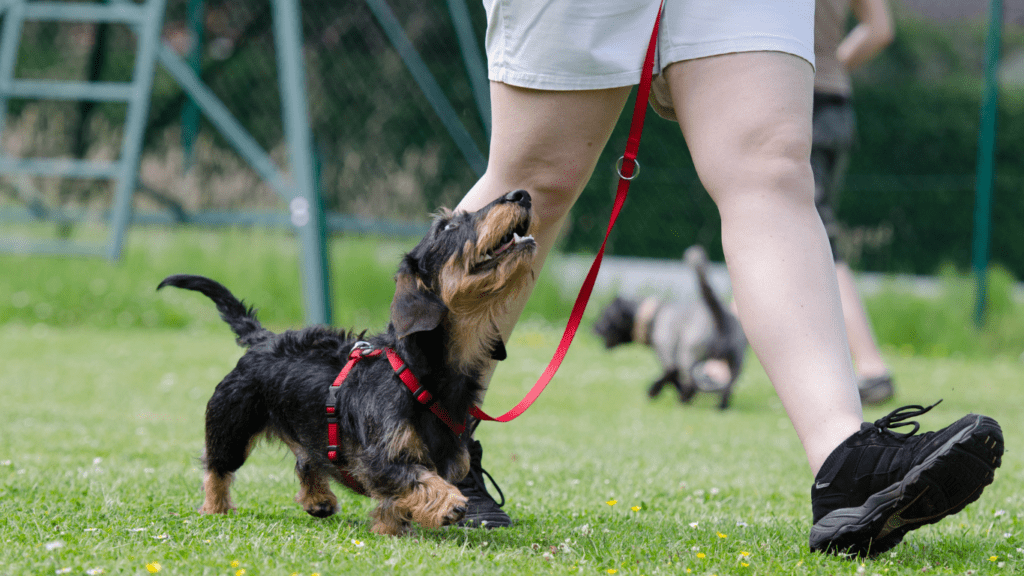Understanding Obedience Training
Obedience training forms the foundation for a well-behaved dog. It promotes effective communication between you and your pet.
What Is Obedience Training?
Obedience training teaches dogs to respond to commands. It covers basic instructions like “sit,” “stay,” and “come,” ensuring your dog behaves appropriately in various situations. This training reduces unwanted behaviors and enhances the dog’s ability to understand and respond to cues.
Basic Obedience Training
- Includes commands like “sit,” “stay,” “come,” and “heel.”
- Ideal for puppies and older dogs needing basic manners.
Advanced Obedience Training
- Focuses on complex behaviors and off-leash commands.
- Suitable for dogs who’ve mastered basic training.
Behavioral Training
- Addresses specific issues like aggression, separation anxiety, or excessive barking.
- Essential for dogs with behavioral problems affecting their quality of life.
Specialized Training
- Covers skills for service, therapy, or agility dogs.
- Required for dogs performing specific roles or tasks.
Each type of training caters to different needs, ensuring comprehensive development and better behavior in your dog.
Behavioral Benefits

Obedience training offers numerous behavioral benefits for dogs, ensuring a well-rounded and well-behaved pet. It addresses key areas that can greatly improve your dog’s overall demeanor.
Reducing Aggression
Obedience training plays a vital role in reducing aggression. Dogs learn to follow commands, reducing dominance-related issues. Training helps establish a clear hierarchy, which is crucial in minimizing aggressive tendencies. Positive reinforcement encourages good behavior and discourages negative ones, leading to a more relaxed and confident dog.
Enhancing Socialization
Training enhances a dog’s socialization skills, making interactions with other animals and humans more pleasant. Well-trained dogs are less likely to exhibit fear or anxiety in new situations.
Socialization during training sessions exposes dogs to various environments and scenarios, building their confidence and ensuring they remain calm and well-behaved in public.
Preventing Unwanted Behaviors
Obedience training prevents unwanted behaviors such as excessive barking, chewing, and jumping. By teaching commands and setting boundaries, dogs understand what’s acceptable.
Consistent training addresses issues directly, promoting positive habits. Proper training techniques help manage and eventually eliminate these undesirable behaviors, ensuring your dog is both a joy to be around and well-adjusted.
Safety Benefits
Obedience training ensures your dog’s safety by teaching them essential commands that prevent dangerous behaviors. A well-trained dog is less likely to put themselves in harm’s way.
Improving Recall
Effective recall training ensures your dog returns to you promptly when called. It helps avoid accidents and potential dangers, such as cars or aggressive animals. Most emergency situations, like escaping a leash or an open door, can be avoided with reliable recall.
Establishing Boundaries and Safety Commands
Obedience training teaches consistent boundaries and essential safety commands. Commands like “stay,” “leave it,” and “come” keep your dog safe in unpredictable environments.
For instance, teaching “leave it” prevents ingestion of harmful objects or toxic substances. Similarly, “stay” can stop them from bolting into traffic.
Strengthening the Bond
Obedience training fosters a deeper connection between you and your dog by establishing clear communication and mutual trust. Through consistent training, dogs learn to understand their role in the household and become more attentive to their owners.
Building Trust
Spending time on obedience training builds trust between you and your dog. Dogs feel more secure knowing their owner’s expectations and boundaries. For example, practicing consistent commands like “sit,” “stay,” and “come” reassures your dog that you are reliable and in control. Trust grows when dogs know they’ll receive consistent feedback and positive reinforcement for good behavior.
Enhancing Communication
Obedience training enhances communication by teaching dogs how to interpret and respond to human cues. Clear commands reduce confusion and frustration for both you and your dog.
Use hand signals along with verbal commands to give dogs multiple context clues. For example, pairing a hand signal with the verbal command “down” helps dogs understand more quickly. With improved communication, dogs respond promptly and accurately, leading to a more harmonious relationship.
Mental Stimulation and Physical Exercise
Obedience training offers significant mental and physical benefits for dogs. It keeps their minds sharp while ensuring they get the exercise they need.
Providing Mental Challenges
Dogs need mental stimulation to stay engaged and happy. Obedience training provides various mental challenges through learning and executing commands (e.g., “sit,” “stay,” “fetch”). These tasks require dogs to focus, make decisions, and remember instructions, stimulating their cognitive functions.
Encouraging Physical Activity
Regular physical exercise is essential for a dog’s overall health. Obedience training incorporates physical activities through commands and routines (e.g., “come,” “heel,” “retrieve”). These exercises keep dogs active, help maintain a healthy weight, and reduce the risk of obesity-related issues. Moreover, practicing commands during walks or play sessions adds enjoyable physical activity to their daily routines.
Long-Term Benefits
Obedience training offers numerous long-term benefits that significantly improve a dog’s overall well-being.
Promoting a Healthier Lifestyle
Training encourages routine physical activity. Commands like “come” and “heel” get dogs moving, helping them stay fit. Regular exercise reduces the risk of obesity-related diseases.
Training activities also enhance cardiovascular health. Beyond physical benefits, structured commands promote mental health. The cognitive challenges associated with learning new commands stimulate brain function, reducing the risk of cognitive decline as dogs age.
Increasing Quality of Life for Your Dog
A well-trained dog enjoys more social opportunities. Socialized dogs are more welcome in public places, enhancing their social interactions.
Dogs that follow commands can safely participate in family activities, increasing their integration into family life. Training helps reduce anxiety and stress, leading to a calmer demeanor. When dogs understand boundaries and expectations, they exhibit fewer behavioral issues, resulting in a more relaxed and enjoyable life.




